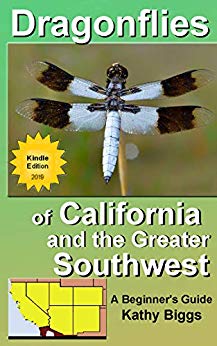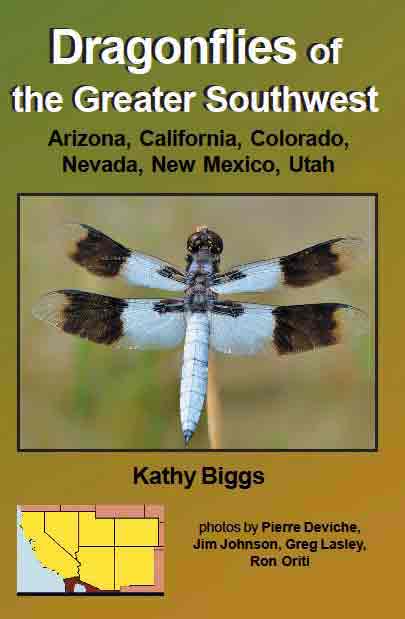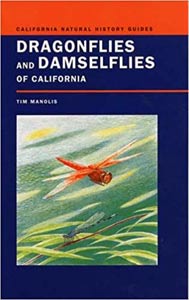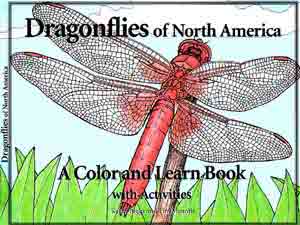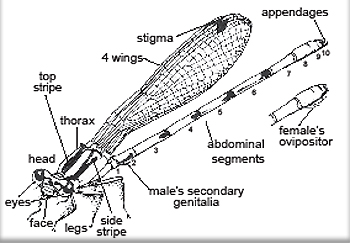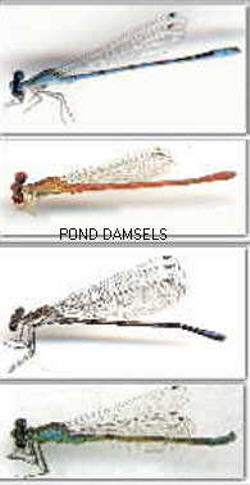|
|
Quick Guide to Pond Damsels (p. 78 Revised Co. Dragonflies of California) |
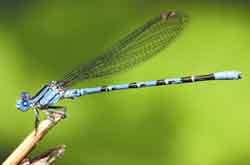
Image by Ray Bruun
Dancer vs. Bluet wing position
pairs tandem ovipositing
image of 3 species in pairs ovipositing
|
GENUS: Argia Dancers - 10 CA species
sizes: medium, lengths 23 - 50 mm
description: males are usually blue (or violet/purplish) & black;
perch with wings held well up and over back, sail-like;
leg hairs 2X as long as space between them;
4th leg joint has 2 rows stiff bristles;
eyes often a dark blue color but not black;
side stripe on thorax often pinched or split
females: 2 forms - most common is tan or gray where male is blue; other is like male;
no vulvar spine on segment 8
nymph: robust
behavior: flight `dance-like' (up & down); 'clap' wings when approached;
alight more frequently in open spaces on rocks &/or wood rather than on vegetation;
more likely at moving waters;
tandem oviposit with male in 'sentinel' position
eggs laid on surface mats of algae, floating vegetation or on wood
|
Photos
male
male
male
male
male
male
male, close-up
male with mites
male, frontal close-up
images by Doug Aguillard at his website
images by Ray Bruun at his Flickr website
images at Odonata of Orange County
male & female
female
female
female
female
female
female
female
male-colored female
female, close-up of thorax
Scans
male
male
female
scan odd pair
|
Vivid Dancer Argia vivida
size: small/medium, length 30 - 40 mm
male: vivid blue & black markings; thorax top stripe has
wide urn
shape; side thoracic stripe pinched at mid-length; middle abdomen
segment sides
have small backwards pointing arrow-shaped/triangular black streaks; blue tip surrounds segments 8-10;
when cool coloring becomes more purple; immatures - milky gray
female: tan/gray & black or male-like
habitat: seeps, streams; wanders
CA flight period: capable of flight whenever there is a prolonged warm spell
CA distribution: common statewide
CA distribution map
Southwestern distribution map
|
Photos
male
male
male
male
male
male
(new early flight data)
male, in hand
male
male
male
pair en cop
images by Ray Bruun at his Flickr website
images by Doug Aguillard at his website
Scans
male
male
male
male
male
male
male
pair
|
California Dancer Argia agrioides
size: small, length 27 - 35 mm
male: brilliant sky-blue; thorax shoulder stripe variably forked (lower stripe can be only interrupted);
blue and black abdomen with pale spots usually at side of black ring, blue "tail" segments 8-10;
distance between lower appendages from above greater
than width of individual appendages, no inward pointing lobe on appendages when viewed from above; dark wing veins and a stripe, not spot on side of seg. 2
female: less colorful, thicker bodied than male; usually tan and black, one form male-like
similar species: VERY similar to Aztec Dancer (see below):
use appendages to differentiate
California Dancer usually has a stripe on segment 2 while the Aztec has a spot;
wing vein color can be useful
Vivid Dancer is larger and has a richer blue, sometimes bluish-violet, color, dark triangles along side of abdomen
habitat: open rivers and streams
CA flight period: late February - late November
CA distribution: statewide
CA distribution map
Southwestern distribution map
|
Photos
male
male
male
male
male
male
male
male
male
male
male
male
male
images by Doug Aguillard at his website
images by Ray Bruun at his Flickr website
pairs
female
female
female (probably this species)
Scans
male
male - AZ
female
|
Aztec Dancer Argia nahuana
size: small, length 27 - 35 mm
male: brilliant sky-blue; thorax shoulder stripe variably forked (lower stripe can be interrupted);
(lower stripe can be interrupted); usually a spot, rather than a dash, on S2, S3-6 have a complete ring, S8-10 have a thin black line along bottom;
distance between lower appendages from above less than width of individual appendages;
inward pointing lope on appendages when viewed from above; spot on segment 2 side (not stripe)
distance between lower appendages from above less than width of individual appendages,
inward pointing lobe on appendages when viewed from above; some brown veins in the wings
female: less colorful, thicker bodied than male; usually tan and black, another form male-like
similar species: VERY similar to California Dancer:
use appendages to differentiate
California Dancer usually has a stripe on segment 2 while the Aztec has a spot;
wing vein color can be useful
Vivid Dancer is larger and has a richer blue, sometimes bluish-violet, color, dark triangles along side of abdomen
habitat: open rivers and streams
CA flight period: April - November
CA distribution: sporadic statewide
CA distribution map
Southwestern distribution map
|
Photos
male
male, close-up of thorax
male
male
male
male (new early flight data)
images by Doug Aguillard at his website
images by Bob Miller at his website
images by Ray Bruun at his Flickr website
female
female
female
female
Scans
male
male
male
male
immature male
male appendages
female
|
Paiute Dancer Argia alberta
size: very small, length 27 - 32 mm
male: smaller and darker than most other dancers; dark thoracic side stripe
prominent and forked; small eye-spots; abdomen mostly dark with thin contrasting blue or grayish purple rings not quite
closed at the top with streaks on the lower sides, middle segments black on top; immatures colored more purple;
wings clear, dark veins
female: light brown/tan & black or male-like
similar species: abdomen similar to Blue-ringed Dancer, but not so distinctly marked or colorful
habitat: stream/pond arid areas
CA flight period: February - December
CA distribution: all desert areas
CA distribution map
Southwestern distribution map
|
Photos
male
male
male
male
images by Bob Miller at his website
images by Doug Aguillard at his website
images by Ray Bruun at his Flickr website
female
female
female
female
pair in tandem
Scans
male - AZ
male
male
female
female
|
Blue-ringed Dancer Argia sedula
size: small, length 30 - 34 mm
male: black abdomen has narrow blue rings separating sections, rings are closed at the top;
blue "tail" 8-10 on top side only; thorax has wide dark side and top stripe; large eyespots;
wings dark veined, sometimes amber tinged;
use appendages to differentiate
female: always paler than male, showing olive-tan wherever
male is blue; wings amber-tinged
similar species: abdomen similar to Paiute Dancer, but more distinctly marked,and more colorful
habitat: sunny sections of small/medium rivers
CA flight period: February - early December
CA distribution: southern Calif. and eastern desert areas
CA distribution map
Southwestern distribution map
|
Photos
male - NV
male - NV
male - NV
male - NV
male - NV
male - AZ
male - AZ
female - NV
female - NV
Scans
|
Kiowa Dancer Argia immunda
size: small/medium, length 26 - 38 mm
male: blue or blue violet & black; pale thoracic side stripe wide
and irregular in shape; dark side stripe forked; large eyespots; abdominal
segments 3-6 unique with thin pale basal ring & then 3 alternating black-pale-
black markings each of approximately the same width; wings clear, dark veins
female: tan where male is blue
habitat: streams & rivers, lakes
CA flight period: found once in state on May 30th
CA distribution: RARE: found once in CA, known from NV & AZ
CA distribution map
Southwestern distribution map
|
Photos
male
male
male
male
male
male
images by Doug Aguillard at his website
images by Ray Bruun at his Flickr website
female
female, close-up of thorax
female, close-up of thorax
male-like female
pair
pair
Scans
male side
male top
male
male
male
immature male
pair
female
female
|
Emma's Dancer Argia emma
size: small/medium, length 34 - 40 mm
male: usually purplish but can be blue; thoracic side stripe pinched at middle, top stripe on thorax unique - very narrow & straight;
abdomen lavender and black with no side triangles, blue 'tail' segments 8-10 can have short black vertical stripes sides of
segments 8 & 9; wings have pale stigma; compare to other species by appendages
female: yellowish tan or more rarely male-like; top thoracic stripe very thin; pale stigma
similar species:
Vivid Dancer has black triangles along side of abdomen, wide top thoracic stripe, can look 'purple' when cold,
females are less 'yellowish' in coloration; Lavender Dancer (below) has split side thoracic stripe, wider top thoracic stripe.
behavior: males perch on rocks or logs jutting above rushing streams or on the nearby shoreline rocks,
and sometimes vegetation
habitat: rocky streams, rivers (not likely at seeps)
CA flight period: March - October
CA distribution: all but southern Calif.
CA distribution map
Southwestern distribution map
|
Photos
male
male
male
male
male
male
male
male
images by Doug Aguillard at his website
multiple images
pair
pair
pair
pair
female - AZ
Scans
|
Lavender Dancer Argia hinei
size: small/medium length 30 - 35 mm
male: violet when mature; thoracic shoulder stripe forked;
frontal stripe wide; mature males show lower half of thorax pruinose
white; segment 8-10 form contrasting blue "tail" with black under 8 & 9 only; prefers shallow rocky stream areas;
use appendages to differentiate
female: light brown; abdomen & thorax patterning similar to
male; dark intrusions on pale tail tip
habitat: streams (even ephemeral)
CA flight period: May - October
CA distribution: southern Calif.
CA distribution map
Southwestern distribution map
|
Photos
male
male
male
images by Ray Bruun at his Flickr website
images by Doug Aguillard at his website
female
male-colored female
male-colored female
male-colored female
female
female
female
Scans
male
immature male
immature male
male head & thorax top
female (brown)
female (blue)
|
Sooty Dancer Argia lugens
size: medium, length 42 - 48 mm
male: large for a damselfly; unlike most Dancers, no blue near abdomen tip;
thorax develops dark sooty blue pruinosity; noticeable pale ring around each segment, lacks blue 'tail'; eyes appear large because they lack obvious eyespots; wings can become slightly smoky, pale stigma; long-legged; immature patterned brown like female
female: thorax patterned blue or brown; pale rings abdomen
behavior: perches on rocks mid-stream
habitat: rocky streams, rivers
CA flight period: April - October
CA distribution: widespread
CA distribution map
Southwestern distribution map
|
Photos
male
male
images by Doug Aguillard at his website
images by Ray Bruun at his Flickr website
male
female
female
female
female
Scans
male
male
male
pair
female
female
female
|
Powdered Dancer Argia moesta
size: medium, length 40 - 49 mm
male: large for a damselfly; develops chalky/powdery pale gray
pruinosity with age, especially thorax; abdomen turns more solid pale gray on segments 8-10 (no blue 'tail');
use appendages to differentiate
female: coppery or sky blue thorax; older females sometimes become a bit pruinose
habitat: rocky rivers, windy lakes
CA flight period: April - November
CA distribution: southern Calif.
CA distribution map
Southwestern distribution map
|
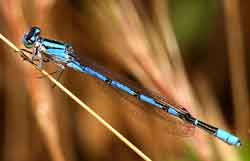
Image by Ray Bruun
Bluet vs. Dancer wing position
photo of a Bluet swarm
Bluet wing position
female Bluet - non-male-like color form
female Bluet - male-like color form
pair in mating "heart"
|
GENUS: Enallagma American Bluets - 9 CA species ...78, 86-89
description: males are usually bright blue & black patterned;
very similar in appearance to Dancers but flight not `dance-like';
wings are held folded down alongside the body, not sail-like over the back as in Dancers;
leg hairs not twice as long as space between them;
eyes often quite black on top unlike dancers which are more often a dark blue color;
the black line on side of thorax often makes a 'jag' or 'elbow' near the head;
females: several color forms: usually tan or gray where male is blue; sometimes colored male-like
but usually with much less blue; have a vulvar spine on segment 8 which Dancers lack
behavior: fly low over the water & grasses along shore;
perch on vegetation with wings slightly drooping at abdomen side;
copulate in wheel position (looks more like a heart than a wheel!); can last up to 44 mins;
males capable of removing sperm from female's prior matings before insemination; usually tandem oviposit, but sometimes females oviposit while single;
eggs laid at still water sites into plant tissue - usually this is floating vegetation,
but females may submerge for up to an hour ovipositing;
males do not submerge with the female; can form swarms over water while ovipositing
nymph: slender, translucent, gray, brown or green; climb about on submerged vegetation along the edges of ponds;
take more than 4 months to mature and about 30 mins. to transform into flying adults on emergent vegetation
habitat: still water with abundant vegetation
|
Photos
male
pair
images by Doug Aguillard at his website
images by Ray Bruun at his Flickr website
appendage close-up
female
female
Scans
male
male
male
male
male
male
male
male
|
Northern Bluet Enallagma annexum [formerly E. cyathigerum ] ...78, 86
size: small, length 30 - 40 mm
male: third segment more than 50% blue; side stripe is undivided
with a jag near the front; large blue eyespots; lower appendages longer than
uppers; a darker NW Coastal form exists
Identify to species by appendages shape using hand lens
female: blue on abdomen reduced to rings, or tan and black
similar species: Boreal Bluets are identical in the field; the 2 species often occur together
across much of California; hybridization is known; separate to species in hand by appendages using 10X lens
habitat: cool still or slow water
CA flight period: March - early November
CA distribution: statewide
CA distribution map
Southwestern distribution map
|
Photos
male
young male
male
males
males
images by Doug Aguillard at his website
images by Ray Bruun at his Flickr website
multiple images
pair
pair
pair
female
female
female
Scans
male
male
male
male
male
male
|
Boreal Bluet Enallagma boreale
size: small, length 30 - 40 mm
male: third segment more than 50% blue; side stripe is undivided
with a jag near the front; large blue eyespots; lower appendages longer than
uppers.
Identify to species by appendages shape using hand lens
female: much less blue (blue reduced to rings), or tan and black
similar species: Northern Bluets are identical in the field; the 2 species often occur together
across much of California; hybridization is known;
separate to species in hand by appendages using 10X lens
habitat: cool still or slow water; mostly found in mountains, not in central valley
CA flight period: end of March - end of September
CA distribution: all, more common in north
CA distribution map
Southwestern distribution map
|
Photos
male
male
male
male
male
male
young male
male & female
female
images by Doug Aguillard at his website
images by Ray Bruun at his Flickr website
pair
Scans
male
male
male
male
female
|
Alkali Bluet Enallagma clausum
size: small, length 30 - 40 mm
male: third segment more than 50% blue; side stripe is
undivided with a jag near the front & sometimes appearing pinched (somewhat similar to a Dancer's); large blue eyespots; lower appendages only
a little longer than uppers. Alkali has thin side stripe; found alkali water.
Identify by appendages shape using hand lens
female: much less blue, or tan and black; entirely pale S8; rather thin humeral stripe
habitat: alkaline ponds and lakes
CA flight period: May - September
CA distribution: east of Sierra Nevada & Cascade Mts.
CA distribution map
Southwestern distribution map
|
Photos
male
male
male
male
male
male
male
male
multiple images
images by Doug Aguillard at his website
images by Ray Bruun at his Flickr website
images by Bob Miller at his website
pair
female
female
Scans
male
male
male
male
male
male
male
male
pair
pair
|
Familiar Bluet Enallagma civile
size: very small, length 29 - 39 mm
male: small comma-shaped eyespots; abdominal markings more blue than black, third segment more than 50% blue;
top thorax stripe dark; upper appendages longer than lowers, large and finlike with pale "button," appears splayed when seen from above;
when seen from side 'tail end' appears triangular in shape; use appendages to differentiate
female: like male or tan and black
similar species: rarer River Bluet E. anna has upper appendages noticeably longer and forked,
only occurs east of Sierra Nevada/Cascade Mts.
Northern, Boreal, & Alkali Bluets have lower appendages the longest; blue areas more angled than on E. civile;
Arroyo and Tule Bluet have 3rd segment more black than blue; use appendages to differentiate
behavior: Bluets fly low over water along shoreline; tandem oviposit on underwater plants floating at surface
habitat: still waters with fields nearby; also slow waters with abundant vegetation; even cattle tanks, and brackish waters;
charactersitic species at disturbed areas; tolerates organic pollution
CA flight period: possibly all year in south
CA distribution: common statewide; especially common in Central Valley & so. CA lowlands
CA distribution map
Southwestern distribution map
|
Photos
males
male
male
male
male
male
male
male
male
female
pairs+
images by Doug Aguillard at his website
female
female
Scans
male
male
male
|
River Bluet Enallagma anna
size: medium, length 29 - 36 mm
male: middle abdominal segments about half-blue from above; usually has a black stripe along the side of S2;
appendages slightly forked; uppers noticeably longer than lowers, with
the top fork extending well beyond lower appendages and angled downward
(without a pale button on end) - noticeable to the naked eye
female: pale areas blue or tan;uniformly black on the abdomen top
similar species: Arroyo, Tule and Familiar Bluet are similar (use CA key)
more common Arroyo Bluet E. praevarum usually averages smaller in size - per. comm. Dennis Paulson, 2010
habitat: slow streams, ditches
CA flight period: early May - September
CA distribution: east of Sierra Nevada & Cascade Mts.
CA distribution map
Southwestern distribution map
|
Photos
male
male
male
male
male
male - AZ
male - AZ
male - MX
male - MX
appendages
appendages
female - AZ
Scans
male - MX
|
Baja Bluet Enallagma eiseni NEW TO USA
size: medium, length 27 - 34 mm
male: distinctive - middle abdominal segments about equally blue and dark from above; dark on abdominal segments forms spears which point towards the tail (other bluets' dark areas point towards head); segments 8 - 10 blue; large blue eyespots have a connecting blue line; upper appendages noticeably longer than lowers, noticeable to the naked eye; from above have inward facing 'hooks'; lower appendages held next to abdomen, appear to be 'missing'
female: pale areas blue or tan, often with greenish cast; patterning similar to male's
habitat: slow streams, pools of desert oases
CA flight period: Found twice in the state in late May and in June
CA distribution: VERY RARE; found only ONCE or twice; report & document all sightings; note: thef irst record has been contested
CA distribution map
Southwestern distribution map
|
Photos
male
male
male
male
male
male
male
images by Doug Aguillard at his website
images by Ray Bruun at his Flickr website
pair
female
female
female
female
Scans
male
male
male
male
male
male
pair
female
|
Tule Bluet Enallagma carunculatum
size: small, length 28 - 37 mm
male: 3rd segment more than 50% black; segments 3-7 more black than blue;
segments 8 & 9 blue; thorax top stripe wide and dark; large pale button tip of upper appendages
female: pale areas blue or tan; no blue on tail
similar species: Arroyo Bluet has forked upper appendages
habitat: lakes, ponds, streams; especially with tules
CA flight period: January - December (possibly all year in the south)
CA distribution: common statewide
CA distribution map
Southwestern distribution map
|
Photos
male
male
male
male
male
male
male
male
images by Doug Aguillard at his website
images by Ray Bruun at his Flickr website
Scans
male
male
|
Arroyo Bluet Enallagma praevarum
size: small, length 29 - 37 mm
male: 3rd segment usually more than 50% black; each segment 3-7 50% less blue than the previous segment;
segments 8 & 9 blue; thorax top stripe wide and dark; upper and lower appendages about the same length,
upper appendages forked, top fork the longest
female: pale areas blue or tan; no blue on tail
similar species: compare to Tule Bluet by appendages;
rarer River Bluet E. anna is found east of Sierra Nevada and Cascade mts. & usually larger in size - per per. comm. Dennis Paulson, 2010
habitat: lakes, ponds, streams, pools of rivers
CA flight period: early March - end of December
CA distribution: widespread but often overlooked
CA distribution map
Southwestern distribution map
|
Photos
male
male
images by Doug Aguillard at his website
images by Ray Bruun at his Flickr website
photo pair
photo female
Scans
scan male - AZ
scan female - AZ |
Double-striped Bluet Enallagma basidens
size: very small, very petite, length 21 - 28 mm
male: blue and black; blue eye spots connected;
both top and side thoracic stripes `doubled' (thin blue line down middle of dark stripes);
blue on end of 'tail' thin, appearing to contain small bluer circles;
upper appendages longest and held in divergent position;
female: like male but can be pale where male is blue; has pale eye stripe
habitat: ponds, lakes, and ditches
distribution: southern species, rare in state;
found east of the Sierra Nevada and near Arizona border
flight period: end of March - October
CA distribution map
Southwestern distribution map
|
Photos
male
male
pair
images by Ray Bruun at his Flickr website
female
Scans
male - OR
pair
pair - OR
female
|
Taiga Bluet Coenagrion resolutum
size: very small, length 27 - 31 mm
male: mostly black above including segments 6&7: pale blue to turquoise markings; green tinged thorax; top pale stripe can be interrupted;
tear-shaped eyespots middle abdomen segments mostly black, black markings on segment 2 are U-shaped;
appendages unique (bottom of page)
female: turquoise, tan, or green; very large eyespots
habitat: slow waters in northern mountains; prefers still, shaded water
CA flight period: May - August
CA distribution: uncommon; northeastern mountains
CA distribution map
Southwestern distribution map
|
Photos
multiple images
male
male
male
male
male
male
male
male
multiple images
images by Doug Aguillard at his website
images by Ray Bruun at his Flickr website
female
female
female
female
female
female
brown form females
brown form female
brown form female
Scans
male
male
male
female
|
Exclamation Damsel Zoniagrion exclamationis
size: small/medium; length 30 - 35 mm
male: slender, forktail-like; black abdomen and thorax with blue markings;
thorax top dark with a pair of turquoise exclamation marks (!!); blue on top of S1&2 and S7-9;
small dark stigma; large uniquely shaped eyespots - inner point faces inwards, while outer point faces forwards.
female: similar or brown, but blue on end of abdomen is only on 2 segments, part of segments 7 and 8;
!! marks on top of thorax may be merged
similar species: larger than most similarly dark Forktail Ischnura species;
Swift Forktail has continuous blue thoracic stripe, not !!; Pacific Forktail females can have !! but blue on abdomen end is different.
use appendages to differentiate
behavior: often rests with wings held slightly open; eggs laid in leaf blades & stems
habitat: permanent pools of mud-banked streams and ponds
CA flight period: March - September
CA distribution: CA endemic; northern coastal and central valley counties
CA distribution map
Southwestern distribution map
|
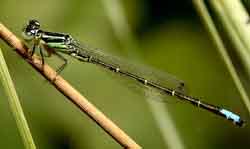
Image by Ray Bruun
nymph |
GENUS: Forktails - Ischnura - 8 CA species
size: small, lengths 20 - 35 mm
description: most are black, with less blue on abdomen than others Pond Damsels;
most appear black with blue showing only on thorax and end of `tail'
males: black with colored markings on thorax;
most have blue markings near end of abdomen;
a few species show yellow or red markings on thorax or abdomen
females: some similar to males, some not;
coloration and markings differ markedly from teneral to adult stages, many show orange when immature;
some become pruinose black or light gray
behavior: females oviposit unescorted into floating vegetation;
may only want to mate once; bend 'tail' down to signal male that she is not receptive;
eggs laid in stems & leaves of aquatic plants;
perch on emergent vegetation
habitat: still water with abundant vegetation
|
Photos
male
male
male
male
male
male
male
male
pair in wheel
pair in wheel
pair in wheel
images by Ray Bruun at his Flickr website
images by Doug Aguillard at his website
female
female
female
female
female
female
Scans
male
male
male
male & female
female
female
|
Swift Forktail Ischnura erratica
size: small/medium, 30 - 35 mm
male: two blue stripes atop black thorax, blue on thorax sides is similar in shape to that of bluets
with a dark intrusion at the rear; larger than most other forktails with bolder markings;
lower appendages are noticeably longer than uppers, long enough to see thru binoculars;
yellow under abdomen with thin yellow rings;
dark abdomen has blue atop segments # 8 - 9; stigma bi-colored with pale at the rear; large eyespots
female: bright green thorax sides, eye spots, and underside; or colored like male; immatreus orange and black;
abdomen top all dark
similar species: larger than other similarly dark Forktail species;
continuous blue side stripe, not the !! of the similarly sized Exclamation Damsel;
Western Forktails are much smaller and have a much more prominent blue line between the post-ocular eye spots;
use appendages to differentiate
CA habitat: ponds, lakes, streams and creeks with lush vegetation, clear water
CA flight period: February - September
CA distribution: CA endemic; northern coastal and central valley counties
CA distribution map
Southwestern distribution map
|
Photos
male
male
male
male
male
male
images by Ray Bruun at his Flickr website
images by Doug Aguillard at his website
pair
mature female
mature female
mature female
mature female
mature female
immature female
male-colored female
Scans
male
male
male
male
young male
female
female
immature female
|
Western Forktail Ischnura perparva
size: very small, length 24 - 31 mm
male: thorax top has 2 blue-green (immature green) stripes, sides on segments 8 & 9 (usually) barely touch top and
bottom; small eyespots point inward. lower appendages forked
female: immature orange & black with segments 1-3 mostly orange; becomes all pale pruinose at maturity
similar species: Mexican Forktail in AZ & so.NV are almost identical, but have
taller 'forks' atop s10
similar species: Swift Forktail is larger, has bi-colored stigma
behavior: females lay eggs solo; only mate once, then curl their 'tail' down to signal
when approached by other males signaling that they are not interested in sex!
habitat: weedy ponds, creeks CA flight period: early March - early November
CA distribution: all Calif. except Imperial County
CA distribution map
Southwestern distribution map
|
Photos
male
male
male
male
male
teneral male
male appendages
images by Doug Aguillard at his website
images by Ray Bruun at his Flickr website
images at Odonata of Orange County
pair
pair
pair
mature female
immature female
immature female
immature female
immature female
male-colored female
male-colored female
male-colored female
multiple individuals, differing color morphs
nymph
nymph
Scans
male
female
female
male-colored female
|
Pacific Forktail Ischnura cervula
size: very small, length 23 - 30 mm
male: abdomen black with blue "tail" markings that touch top & bottom; upright 'fork' at top end of tail;
black thorax top has 4 tiny blue spots, 1 each "corner", thorax sides aqua-blue;
use appendages to differentiate
female: immature shows stripes on top of thorax and pinkish-orange eyespot color;
becomes all dark pruinose when mature; pale stigma; long hairs extend from prothorax toward the midline;
abdomen tip pattern - 2 narrow blue rings bracketing segment 8; male-colored female
male-like form usually has larger dots atop thorax than male; all forms under magnification show pencil hairs on the hind margin of the prothorax
similar species: Plains Forktail in AZ has much less of a 'fork'
nymph: tan or greenish
habitat: weedy ponds & creeks
CA flight period: all year in south (early date is usually Feb. in the north)
CA distribution: common statewide
CA distribution map
Southwestern distribution map
|
Photos
male
male
male
male
male
male
young male
immature male
pair
images by Ray Bruun at his Flickr website
images by Doug Aguillard at his website
images at Odonata of Orange County
female
female
female
young female
Scans
male
male
male
female
male & females
|
Black-fronted Forktail Ischnura denticollis
size: very small, frail; length 21 - 26 mm
male: thorax top all dark with no stripes or dots, sides blue (green in immature); small circular eyespots;
blue patches on top & bottom segments 8-9 do not touch; chartreuse underside; stigma has white margin at rear;
top appendages bent down.
female: immature - pale coral; mature green/blue thorax sides
similar species: the very rare San Francisco Forktail is the 'twin' to the Black Fronted
(comparison photo),
but has differently shaped appendages; lacks the white margin at the rear of the stigma:
all 'Black-fronted' type forktails seen in the Bay Area that don't have white-margined stigma should be examined in hand.
The two species have been known to hybridize. Compare in hand by
appendages
habitat: lakes, ponds, seeps
CA flight period: all year in south (March is usual early date in north)
CA distribution: statewide except northern coastal area
CA distribution map
Southwestern distribution map
|
Photos
male
male
male
male
male
male
male
male
female
images by Ray Bruun at his Flickr website
multiple images by Alan Wight
pair in tandem
pair in wheel
female
mature female
mature female
immature female
Scans
male
male
male
male
male
male
pair
female
|
San Francisco Forktail Ischnura gemina
size: small, length 24 - 28 mm; wingspan ~28 mm
male: thorax top and abdomen dark; blue spots on segments 8 and 9; underside chartreuse; appendages up-pointing
female: cryptic brown, reddish, or male-like
similar species: very similar to Black-fronted Forktail,
hence the Latin name `gemina' for twin; SF Forktail is slightly more robust;
compare the two by
appendages,
appendages; SF Forktail lacks white margin
at rear of stigma; eye spots back of head are more circular in shape than Western's or Pacific's; hybridization ocurring.
CA habitat: weedy ditches; often near salt water
CA flight period: March - early November
CA distribution: CA endemic; S.F. Bay Area ONLY; range shrinking; rare: currently only found SF Airport to Sonoma Co. line; PLEASE REPORT ALL SIGHTINGS
CA distribution map
Southwestern distribution map
|
Photos
male
male
male
male
male
images by Doug Aguillard at his website
images by Ray Bruun at his Flickr website
pair in wheel
mature female
mature female
female
immatue female
immature female
immature female
Scans
male
male
male side - TX
female
|
Citrine Forktail Ischnura hastata
size: very small, length 20 - 25 mm; smallest Odonate in North America
male: abdomen (even tip) mostly yellow above & below with some
black; thoracic stripes green/yellow; forewing has a pale reddish-brown stigma that is NOT
touching the leading edge; hind wing has (usual) dark stigma;
tail end YELLOW with strong 'fork'
female: immature is orange & black with segments 1-4 mostly orange;
mature is pale pruinose on abdomen but shows dark atop thorax
habitat: lushly vegetated marshes/ponds/streams
CA flight period: March - November
CA distribution: southern Calif.
California distribution map
Southwestern distribution map
|
Photos
male
male
male
male
male
males
images by Doug Aguillard at his website
images by Ray Bruun at his Flickr website
pair
pair
pair
immature female
immature female
dispersal/migratory event
Scans
young male
comparative scan Ramburs/Desert males
male-colored female
male-colored female
comparative scan Ramburs/Desert females & males
female
male - AZ
|
Rambur's Forktail Ischnura ramburii
size: small/medium, length 27 - 35 mm
male: green-blue shoulder stripe very thin, parallel sided; tiny
circular eyespots; sides of thorax and segments 1-2 greenish-blue; yellowish-orange
underside only of segments 3-6, black above; blue surrounds segment 8, part of 9, not top of 10;
lower appendages point straight out
female: male-like or Day-Glo red/orange turning tan/olive, upper surface of the abdomen solid black, not orangish,
wide black stripe thorax top
similar species: Desert Forktail has wider side stripe, larger tear-drop shaped eyespots and yellow from underside
curls up onto top of abdomen - comparison shot Rambur's & Desert males ;
see also this info from AZ
habitat: pond/lake/slow streams; probably increasing here in California,
from which it was first recorded not many years ago. It does well in human-altered environments
CA flight period: all year
CA distribution: southern Calif.
CA distribution map
Southwestern distribution map
|
Photos
male
male
male
male
male
male
images by Bob Miller at his website
images by Doug Aguillard at his website
images by Ray Bruun at his Flickr website
pair
female ovipositing - AZ
Scans
male
male
male
male
male
male
comparative scan Rambur's/Desert males
comparative scan Rambur's/Desert males
pair
pair
|
Desert Forktail Ischnura barberi
size: small/medium, length 27 - 35 mm
male: pale shoulder stripe thicker than Rambur's, widest near eyes;
large tear-shaped eyespots connected by a line; pale orange on mid segments curves partly up & over
the abdomen leaving the dark areas on top appearing dart shaped; blue surrounds all of
segments 8 & 9; lower appendages point upward
female: like male or pale tan-orange; narrow top stripe
similar species: Rambur's Forktail has narrower side stripe, small circular shaped eyespots
comparison shot Rambur's & Desert males ;
see also this info from AZ
habitat: pond/lakes/slow streams
CA flight period: early March - November
CA distribution: southern Calif. & Colusa County (Bear Creek @ Sulfur Creek)
CA distribution map
Southwestern distribution map
|
Photos
male
pair - Siskiyou County Voucher
images by Ray Bruun at his Flickr website
images by Jim Johnson at his Dragonflies and Damselflies of the Northwest and Beyond website
Scans
pair
pair - OR
pair - OR
male - WV
female - WV
|
Sedge Sprite Nehalennia irene
size: very small, slender, length 25 - 30 mm
male: mostly dark with green; top of thorax and abdomen metallic
green; middle segments at least 50% black from above; thorax top entirely
metallic green, sides blue; abdomen blue in male, green for females; black areas
whole length of abdomen; black spot rear of 2nd abdominal segment
CA habitat: slow waters: sedge
marshes/bogs/lakes/ponds/streams/rivers
female: very similar to male
CA flight period: June - August
CA distribution: northern CA (Mt. Lassen area)
CA distribution map
Southwestern distribution map
|
Photos
male
male
male
male
images by Doug Aguillard at his website
images by Ray Bruun at his Flickr website
pair
pair in wheel
female
female
female
female
Scans
male
male
male - OR
female
pair
|
Western Red Damsel Amphiagrion abbreviatum
size: very small, length 24 - 30 mm
male: stocky; hairy black head and thorax, brown eyes,
black on top; bright red abdomen barely extends beyond wings; black top and/or sides
segments 7-10; dark legs
female: stout; pale peach to reddish; thorax tawny; rare dark pruinose form exists
habitat: mountain lakes, marshes, slow streams
CA flight period: April - September
CA distribution: most areas
CA distribution map
Southwestern distribution map
|
Photos
male
male
male
male
male
images by Ray Bruun at his Flickr website
images by Doug Aguillard at his website
pair
pair
pair
pair
female - AZ
Scans
male
male
males
|
Desert Firetail Telebasis salva
size: very small, length 24 - 29 mm
male: dainty and slender; all red abdomen extends well beyond wing tips;
red face and eyes; black eye spots; thorax red with black; red legs; tip
of abdomen without black
female: some black thorax top; eggs laid in algae mats
habitat: shallow waters with algae scum; lowlands (not just in deserts)
behavior: flies in the afternoon, often seen on algae mats
CA flight period: March - December
CA distribution: all but far northern Calif.
CA distribution map
Southwestern distribution map
|
Family: SPREADWINGS - Lestidae
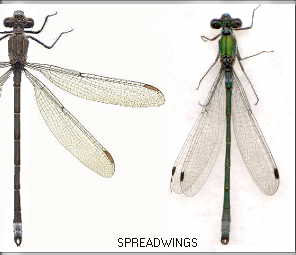
|
Family: SPREADWINGS - Lestidae
2 CA genera - Pond Spreadwings and Stream Spreadwings
sizes: small to medium/large, slender; lengths: 30 - 62 mm
males: long; dark with blues, greens; blue eyes; pruinose pale area near tip;
some show more extensive pruinosity
females: more stout; less colorful; not pruinose
habitats: ponds, marshes, streams, slow rivers
behaviors: often hold wings open when at rest, a la stealth
bombers; oviposit in plant tissue that is above water level
Pond Spreadwings Lestes - 5 CA species; found flying at still water sites
spring through fall; patrol shoreline from emergent vegetation on which they rest;
oviposit while in tandem into non-woody vegetation above the water level;
comparison by appendages sometimes necessary for making identifications
Stream Spreadwings Archilestes -
2 CA species; moving water sites;
our largest damselflies; tandem oviposit into woody vegetation such as bay,
alder & willow branches overhanging creeks/small rivers (even when dry); late season flight
|
Photos
male
male
male
male
images by Ray Bruun at his Flickr website
images by Doug Aguillard at his website
pair
pair
female
female
Scans
male
male
male
male
male underside - BC
female
pair
female
female
|
Spotted Spreadwing Lestes congener
size: small/medium, slender, length 34 - 40 mm
male: blue eyes; thorax dark with light brown 'shoulder' stripe; first and last two abdominal segments
pruinose gray-blue; other segments are dark or with a green sheen;
short lower appendages
<50% of uppers; 4 dark spots thorax
underside; dark brown stigma
female: more stout; less colorful; 4 dark spots thorax
underside
habitat: weedy ponds, streams
CA flight period: May - December
CA distribution: common statewide
CA distribution map
Southwestern distribution map
|
Photos
male
male
male
images by Ray Bruun at his Flickr website
images by Doug Aguillard at his website
pair in wheel
female
Scans
male
male
male side
male
male
male
young male - OR
female
female
female
|
Northern [formerly Common] Spreadwing Lestes disjunctus
size: small/medium, slender, length 30 - 40 mm
male: blue eyes; thorax becomes pruinose pale blue; first two and
last three abdominal segment become pruinose gray-blue; other segments
have dark/green sheen;
lower appendages long & straight but may be held crossed
or like a V (examine carefully with hand lens); black stigma
female: more stout; much less pruinosity; ovipositor does NOT extend beyond end of abdomen
habitat: weedy ponds, streams
CA flight period: April - October
CA distribution: central & northern Calif.
CA distribution map
Southwestern distribution map
|
Photos
male
male
male
images by Ray Bruun at his Flickr website
images by Doug Aguillard at his website
images by John Sterling at his website
female
female
Scans
male
male
male
male
male
male
male
|
Lyre-tipped Spreadwing Lestes unguiculatus
size: small/medium, slender, length 30 - 40 mm
male: blue eyes; thorax top dark; first & last two abdominal segments
pruinose gray-blue; s8 not solidly pruinose (dark unpruinose wedge on S8);other segments are dark or have a green sheen;
lower appendages lyre-shaped;
dark brown stigma often has white at outer edges
female: more stout; less colorful
similar species: compare to Northern Spreadwing which occasionally crosses it's appendages,
making them look lyre-shaped unless you check very carefully
habitat: weedy ponds, streams
CA flight period: June - September
CA distribution: northern hills and mountains
CA distribution map
Southwestern distribution map
|
Photos
male
male
male
male
male
male
male
male
teneral male
images by Doug Aguillard at his website
images by Ray Bruun at his Flickr website
pair ovipositing
pair ovipositing
female
female
teneral female
Scans
male
female
females
|
Black Spreadwing Lestes stultus
size: small/medium, slender, length 35 - 42 mm
male: top of thorax black sometimes bronzy in immature, sides blue;
abdomen has metallic green sheen, first two and only last two segments show pruinose blue;
appendages are long and broad at the end ("boot-shaped"); stigmas tips pale;
short and stocky appearance
female: more stout; more brown, sometimes coppery; emerges pinkish
similar species: Emerald Spreadwing has same appendage shape, but metallic emerald top to thorax (see below)
habitat: sloughs, ditches, ponds
CA flight period: March - late August
CA distribution: mostly northern Calif.
CA distribution map
Southwestern distribution map
|
Photos
male
male
male
male
young male
images by Ray Bruun at his Flickr website
female
female
female
Scans
male
male
male
male
male
female
female
|
Emerald Spreadwing Lestes dryas
size: small/medium, slender, length 32 - 40 mm
male: top of thorax bright metallic green (immature is bronzy); sides of thorax pale;
abdomen bright metallic green; first two and last 2-3 segments show blue pruinosity;
appendages are long and broad at the end ("boot-shaped")
female: stocky; usually less emerald; sometimes coppery
habitat: forested mountain areas
CA flight period: April - early October
CA distribution: hillsides statewide
CA distribution map
Southwestern distribution map
|
Photos
male
male
male
male
male
male
male
teneral male
images by Ray Bruun at his Flickr website
images by Doug Aguillard at his website
multiple images
female
female
tandem pair
pair ovipositing
ovipositing pair
ovipositing pairs
ovipositing pairs
Scans
male
male
male
|
California Spreadwing Archilestes californicus
size: medium/large, slender, length 48- 58 mm
male: long brown body with pruinose area near tip; 2
incomplete white stripes thorax sides; blue eyes; wings colorless, stigma from above pale;
upper appendages semicircular, lower are short and parallel; late season flier
female: less colorful brown tones
similar species:
compare to Great Spreadwing which has a thoracic side stripe that is continuous across area
habitat: ponds and slow streams
CA flight period: May - February
CA distribution: sporadic statewide; not found east of the Sierra Nevada/Cascades
CA distribution map
Southwestern distribution map
|
Photos
male
male
young male
male
male
male
male
pair ovipositing
pairs ovipositing into Bay Tree branches
female
female
female
female
female
Scans
male
male
female
female
|
Great Spreadwing Archilestes grandis
size: medium/large, slender, length 50 - 62 mm; North America's largest damselfly
male: long abdomen gray with greenish sheen, pruinose area near tip;
one continuous pale yellow side stripe on thorax (white in immature); blue eyes; dark
stigma; top appendages semicircular, lowers divergent; North American's largest
damselfly; late season flier
female: less colorful
similar species:
compare to CA Spreadwing which has a thoracic side stripe that is not continuous across area and
by appendages
habitat: streams with overhanging alders/willows/bay
CA flight period: March - January (late season flier)
CA distribution: very sporadic statewide; not found east of the Sierra Nevada/Cascades
CA distribution map
Southwestern distribution map
|
Family: BROAD-WINGED DAMSELS -
Calopterygidae 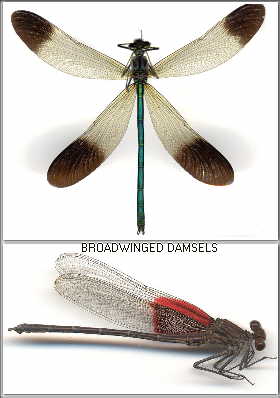
|
Family: BROAD-WINGED DAMSELS - Calopterygidae
2 CA genera, Jewelwings and Rubyspots
sizes: medium/large, slender; lengths: 40 - 52mm;
males: large for damselflies; showy; colorful patches in wings
females: more stout; less colorful bodies and wings
habitats: streams, slow rivers, esp. with vegetation
behaviors: butterfly-like courtship &/or male display flights;
perch horizontally, head down on vegetation, shoreline & mid-stream rocks
Jewelwings Calopteryx - 1 CA species; large broad wings with outer third black;
beautiful green and blue iridescent coloration on body changes with angle of viewing; long spindly legs;
butterfly-like courtship displays; males defend territories
Rubyspots Hetaerina - 1 CA species*; males have basal quarter to third of broad
wings with beautiful ruby red patches on upper surface; thorax matures to red as seen through smoky glass or to dark with reddish iridescence; very long dark legs; males duel in display flights
|
Photos
male
male
male
male
male
male
male
male
male
multiple images
images by Bob Miller at his website
images by Doug Aguillard at his website
images by Ray Bruun at his Flickr website
images at Odonata of Orange County
female
female
female
female
female
female
Scans
male
male
female
|
American Rubyspot Hetaerina americana
size: medium/large, length 40 - 46 mm
male: wings ruby red basal 1/3 to 1/2; thorax dark with metallic red or blood red as if under
black glass, pale side stripes; abdomen bronzy brown-green to red with thin pale rings; in CA
usually no stigma, other states pale stigma; appendages have 1-2 toothed lobes
female: less colorful; wing streaks leading edge orange, less defined,
tips mostly clear, can have tiny white stigma
similar species: like no other California damselfly; BUT in the southern part of CA and Merced County*
compare to Canyon Rubyspot H. vulnerata* (see below) by appendages: vulnerata lacks tooth-like projection on inner side of upper appendages; wingtips are smoky
*there is a questionable record for CA from this county
behavior: perches on rocks or logs in the middle of a stream; flicks wings to attract females;holds its wings closed and off to one side of the abdomen;
females may oviposit completely submerged
habitat: open streams, rivers
CA flight period: capable of year round flight in the south in good weather
CA distribution: common statewide
CA distribution map
Southwestern distribution map
|
Photos
male - AZ
male - AZ
male - UT
male - NM
male - NM
male - AZ
male
Scans
male
female |
*Canyon Rubyspot Hetaerina vulnerata* ...not in CDC (revised)*
size: medium/large, length 36 - 49 mm
male: red at wing base usually less extensive than
American Rubyspot's; smoky edge/wing-tip; no stigma; compare by appendages American - upper appendages 1-2 toothlike lobes inside at midpoint; Canyon lacks these lobes
female: less colorful; wing patches orangish, no stigma, smoky wing tips
habitat: canopied streams, rivers
CA flight period: not known
CA distribution: *early dubious CA report, San Bernardino Co., but is known in adjacent AZ
NO CA distribution map
Southwestern distribution map
|
Photos
male
male
male
male
pair in cop
images by Ray Bruun at his Flickr website
images by Doug Aguillard at his website
female
female
female
females
female
ngs conspicously black; long black legsfemale
immature female
photos of behaviors
Scans
male
male
male
female
female
|
River Jewelwing Calopteryx aequabilis ...pg. 108,110
size: medium, length 46-52 mm
male: jewel-like bright iridescent metallic green/blue thorax and abdomen; outer 1/3 of wings conspicuously black; long legs
female: abdomen more dull and with a pale tip; smoky wings have a contrasting
pale stigma
behavior: perch on rocks or logs in the middle of a stream or on tules or grasses stream-side; butterfly-like courtship flights;
females sometimes oviposit totally submerged
habitat: fast waters of large wooded streams/rivers; nymph live in
root masses
CA flight period: early May - August
CA distribution: northern Calif.
CA distribution map
Southwestern distribution map
|
I'm glad you enjoy the dragonflies and damselflies too! THANK-YOU for visiting!!
